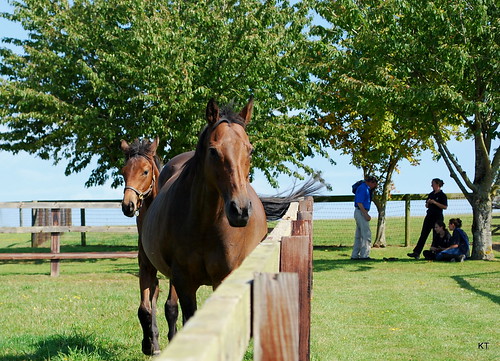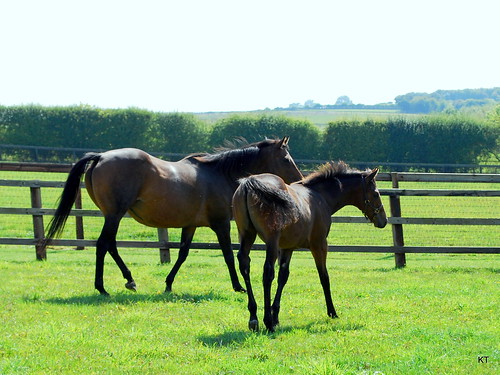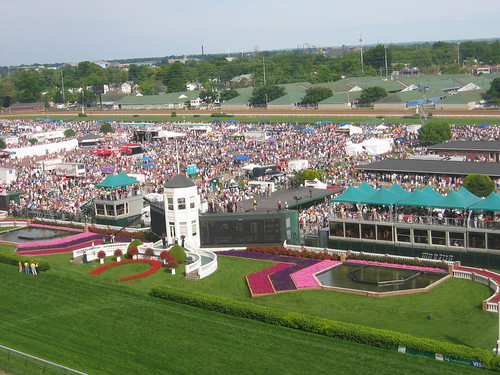Horse Breeds – Thoroughbreds
Thoroughbreds are known as “America’s Racing Horse”. This breed of horse runs at the race track every single day around the world.
History of the Thoroughbred
This breed of horse was originally bred in England due to the English horsemen’s desire to have a fast race horse. There are three that founded this bloodline which are: Byerley Turk, Darley Arabian and Godolphin Arabian, named after their respective owners, Thomas Darley, Lord Godolphin and Captain Robert Byerley.
All of these stallions were imported to England from the Mediterranean Middle East between 1670 and 1710. The result was an animal that could carry weight with sustained speeds over extended distances. Approximately ninety percent of modern thoroughbreds have descended from Eclipse whose grandsire was Darley Arabian, who was never beaten in eighteen races.
Breeding of the Thoroughbred
This began a very selective breeding process which has been going on for nearly 250 years. Breeding the best stallions to the best mares to produce fast race horses, giving them superiority and excellence being established on  the race track.
the race track.
Around the turn of the 1700’s, breeding records for Thoroughbreds were sparse and usually incomplete, and many times, they would not name a horse until the young horse had proven them self worthy. A gentleman named James Weatherby, through his own research and hard work and by the consolidation of his own privately kept pedigree records published the first volume of the General Stud Book. This was done in 1791. The first publication listed 387 mares, each of which could trace back to Eclipse. The General Studbook is still published in England by Weatherby and Sons, Secretaries to The English Jockey Club.
Many years later, as thoroughbred racing proliferated in North America the need for a pedigree registry for American Bred Thoroughbreds, similar to the General Stud Book became apparent. In 1873, the first American Stud Book was published by Colonel Sanders D. Bruce. This man spent almost a lifetime researching the pedigrees of American Thoroughbreds. He followed the pattern of the General Stud Book producing six volumes of the register until 1896 when the project was taken over by The Jockey Club. The integrity of the American Stud Book is the foundation on which all Thoroughbred racing in North America Depends.

The first publication of the American Stud Book by The Jockey Club had a foal crop of around 3,000. In 1986 in had grown to an astonish 51,000. Today The Jockey Club runs an elaborate new computer technology to meet the registration challenges posed by the gigantic number of annual registrations. The Jockey Club owns and operates one of the most sophisticated computer operations in the world today, with its database holding more than 1.8 million horses on a master pedigree file, with names that trace back to the 1800’s. This is quite impressive genealogy. As well as bloodlines, this computer system also handles daily racing results of every Thoroughbred race in North America, as well as the ability to process electronically submitted pedigree and racing data from England, Ireland, France and other leading Thoroughbred countries.
Another descendant of Darley Arabian is Diomed; he won the first running of the Kentucky Derby in 1780. When he was twenty one years old he was brought to the United States where he produced the male line through his son, Sir Archie.
The most world renowned horse race is the Kentucky Derby, being the first race of the Triple Crown. The Preakness and The Belmont follow this historical racing event. Thoroughbreds are the horse of choice for track racing. Most thoroughbreds are born between January and April, but their official date of birth is January 1 of the current year.
During their first year of growth, they are developing size and power with the youngster beginning his training as a yearling. The horse learns to accept a bridle and a saddle and soon after a rider on his back to break the horse and prepare him for the starting gate and the run around the track.


 Try these three powerful exercises to get strengthen your position.
Try these three powerful exercises to get strengthen your position.

Thoroughbreds have always been an excellent race and people are very interested by them. Nowadays a lot of thoroughbreds are present and bought for horse racing. And horse racing is a good way to create a community around horses’lovers and business men. Participate in it allows people to win and save money thanks to syndicates which help them to buy horses. Horse racing is such a good way to create a new business!